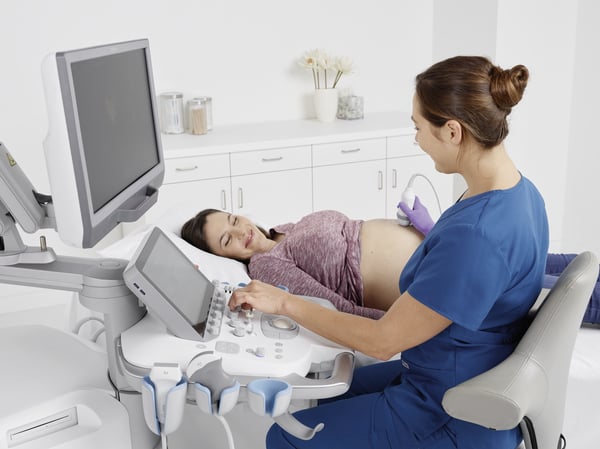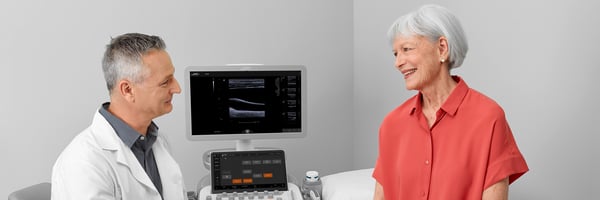
The technical component of sonography is only part of the picture.
That’s not exactly a controversial statement. Most clinics and hospitals pride themselves on the premium level of care they provide to patients, and that includes showing compassion and helping the patient to understand their medical situation.
After all, most sonographers get into the profession not because they’re excited about the technical specifications of the ultrasound process (although that certainly plays into it). If you’re anything like me, you became a sonographer in order to work with people who may be going through tough medical situations, to provide answers to their problems, to see the joy on the face of a mother when she sees her unborn child for the first time.
The sonographers I encounter have a deep-seated passion for helping people. I wanted to share some of the patient experience tips I’ve picked up in my own ultrasound career, either in my own clinical work or in conversation with Cassling customers. I’m always impressed with the little touches that go a long way toward affecting the patient’s impression of their provider. Hopefully, you’ll find these tips helpful as well.
Talk It Out
In the middle of an extensive ultrasound sequence where the patient might be lying down for 30 minutes or more, many of us like to break the silence by asking details about the patient’s family, work, hobbies, etc. This is great! It helps to keep the patient at ease and it demonstrates a level of compassion the patient will truly appreciate.
During these conversations, make sure to practice active listening. Rather than posing a set of stock questions to the patient and then moving on to the next subject, really listen and respond to what they have to say. Show the patient that you see them as a person rather than just your 2 o’clock appointment block.
Ideally, you’re already doing this. What I want to recommend is going to the next level and not just posing questions to the patient but explaining in detail the test they’re currently experiencing. I’ve found that most patients, especially first-time patients unaccustomed to an ultrasound, are fascinated to hear about how the ultrasound system works, the purpose of capturing an image from multiple angles, the reasoning behind the sequence you’ve selected and even the inner workings of the ultrasound system and transducer. Research has even shown that when people deliberately talk through what they’re about to do, their actions will be safer and more accurate.
As ultrasound procedures become more common thanks to the non-invasive nature of the exam, you’re going to encounter far more patients who are receiving their ultrasound for the first time, and this provides a unique opportunity to educate the people who walk through your doors. Tell them about the cool features of the transducer and the system. Show them the images as they’re acquired, pointing out different parts of the patient’s anatomy where appropriate.
When we’re pressed for time, have a line of appointments stretching into the afternoon and feel like we need to hustle people in and out of the clinic, it’s easy to neglect these simple, straightforward interactions that we probably learned back in college. By being as open with the patient as you hope they will be to you, you’ll create an experience that person will never forget.
Keep Reactions Limited
It’s one of the worst feelings in the world in this profession: you’re conducting a sequence when you see something that is definitely not good news for the patient.
If you’ve been doing this long enough, you definitely know when something in the ultrasound betrays a likely problem with the patient’s health. It’s not necessarily our job, however, to communicate what we see in these images to the patient; instead, it’s up to us to capture them, provide initial judgment and send our findings to the physician, who ultimately has to discuss the results with the patient.
You have to get really comfortable with continuing your train of conversation with the patient even while imaging an abnormality that will no doubt have a serious impact on their health. It’s pretty difficult to mask your reaction when that happens, especially early in your career, but it’s essential so as not to cause the patient undue or potentially unnecessary worry.
That’s not to say you can’t be honest. A sentence like “It looks like we have an abnormality here that your physician is probably going to want to look at” is acceptable, particularly if the patient has questions. “I’m 99% sure this is a tumor” is not acceptable. It’s all about walking the fine line between empowering the patient with information about their condition while not steering them down one way of thinking before they have a chance to speak with their doctor.
Technology
As technology improves, having the right system in place can go a long way toward improving the patient experience as well. All the things you like about the newest ultrasound systems on the market are also the things that benefit your patients. Automated sequencing and one-touch image capture that improves scan times? Yes, it makes your job easier, but it also gets the patient in and out of the exam room more quickly too, and that’s something they’ll always appreciate.
As image detail becomes better and better, the need for lengthy attempts to capture the image or schedule additional exams becomes less and less. More than ever, sonographers are able to capture precisely what the radiologist needs on the first try. And because sonography is becoming a go-to procedure, having access to a system that can help you oversee more advanced exams is something the patient will appreciate, even if they don’t necessarily realize that what’s possible now was a fantasy just a few years ago.
One other technological development that’s dramatically improving the patient experience is the increased depth penetration available on modern systems. The ACUSON Sequoia from Siemens Healthineers, for example, can penetrate tissue up to 40 cm in depth. The increased penetration makes the exam easier for sonographer and patient alike and can reduce exam times.
Ergonomic Comfort
Self-care is the first step to patient care. Your patient isn’t going to receive the best experience if you yourself aren’t at your best.
This is why I encourage everyone I work with to really take the time to assess their work area and see what they can do to improve ergonomic comfort. I’ve previously addressed the subtle changes you can make to your technique and your workspace in order to ease the physical burden of the job, and if you’re currently in a bad ergonomic situation, I would encourage you to revisit those tips.
Take just a few moments before each exam to center your body and remind yourself to make deliberate, smooth motions throughout the test. This will go a long way toward getting into the right headspace to provide an exceptional patient experience.
These are just a few small things that really can make all the difference for a positive patient experience. To learn more about improving overall patient experiences, subscribe to our blog.









Comments